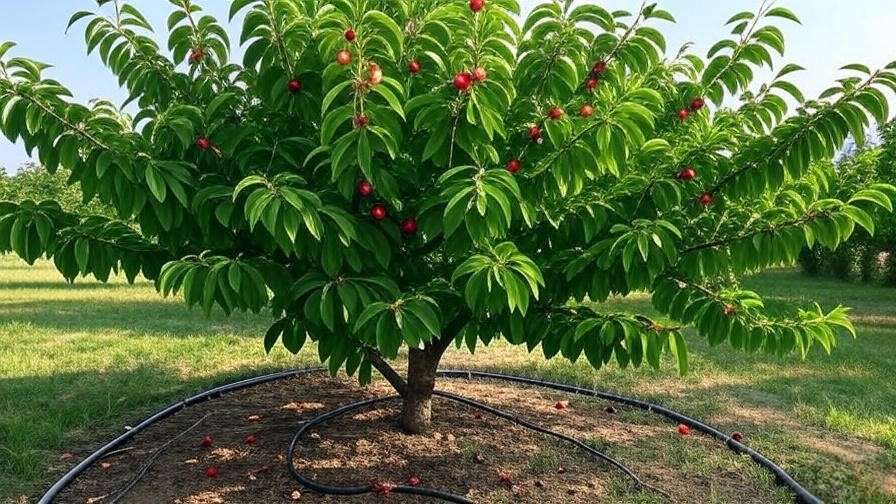Imagine stepping into your garden to find your cherry trees laden with plump, juicy cherries, their branches heavy with vibrant fruit. This dream can become reality with The Best Cherry Tree Watering System for Maximum Growth. Watering is the cornerstone of healthy cherry trees, yet many gardeners struggle with inconsistent hydration, leading to stunted growth or disappointing yields. Whether you’re nurturing a single backyard tree or managing an orchard, this comprehensive guide, backed by horticultural expertise, will equip you with science-based techniques and practical solutions. From drip irrigation to smart technology, discover how to transform your cherry trees into thriving, fruit-producing marvels. Let’s dive in! 🌟
1. Why Proper Watering is Critical for Cherry Trees 🌿
Water is the lifeblood of cherry trees, fueling everything from root development to fruit production. Without a consistent and tailored watering system, your trees may suffer from stress, reduced yields, or even disease. Let’s explore why watering is so vital and how to get it right.
1.1 The Role of Water in Cherry Tree Growth
Water facilitates nutrient uptake, supports photosynthesis, and ensures healthy cell development in cherry trees. It’s especially critical during fruit development, as water helps form plump, flavorful cherries. According to a 2023 study by the University of California Agriculture and Natural Resources, proper hydration can increase cherry yields by up to 30%. Conversely, under-watering leads to weak roots and small fruit, while over-watering risks root rot or cracked cherries. A balanced approach is key to maximizing growth and health.
1.2 Cherry Tree Watering Needs by Growth Stage
Cherry trees have distinct watering needs depending on their age and growth phase:
- Young Trees (0–3 Years): Newly planted trees need frequent, light watering to establish deep roots. Aim for 5–10 gallons weekly, ensuring the soil stays moist but not waterlogged.
- Mature Trees (4+ Years): These require deeper, less frequent watering to support established root systems—about 20–30 gallons every 7–10 days, depending on weather.
- Fruit-Bearing Season: During flowering and fruit set (spring to early summer), increase watering to support energy demands, providing 25–35 gallons weekly.
| Growth Stage | Weekly Water Needs | Frequency |
|---|---|---|
| Young Trees | 5–10 gallons | 2–3 times |
| Mature Trees | 20–30 gallons | 1–2 times |
| Fruit-Bearing | 25–35 gallons | 1–2 times |
Expert Tip: Invest in a soil moisture meter to eliminate guesswork and ensure precise watering. 🌡️
2. Understanding Your Cherry Tree’s Environment 🌞
To create an effective watering system, you must understand your tree’s environment. Soil, climate, and sun exposure all influence how much and how often you should water.
2.1 Soil Types and Their Impact on Watering
Soil composition dramatically affects water retention and drainage:
- Sandy Soils: Drain quickly, requiring more frequent watering (e.g., every 3–4 days). Add organic matter like compost to improve retention.
- Loamy Soils: Ideal for cherry trees, balancing drainage and moisture. Water every 5–7 days.
- Clay Soils: Retain water longer, so water less often (every 7–10 days) to avoid root rot.
Test your soil by digging a small hole and observing drainage after watering. If water pools for hours, improve drainage with organic amendments or raised beds.
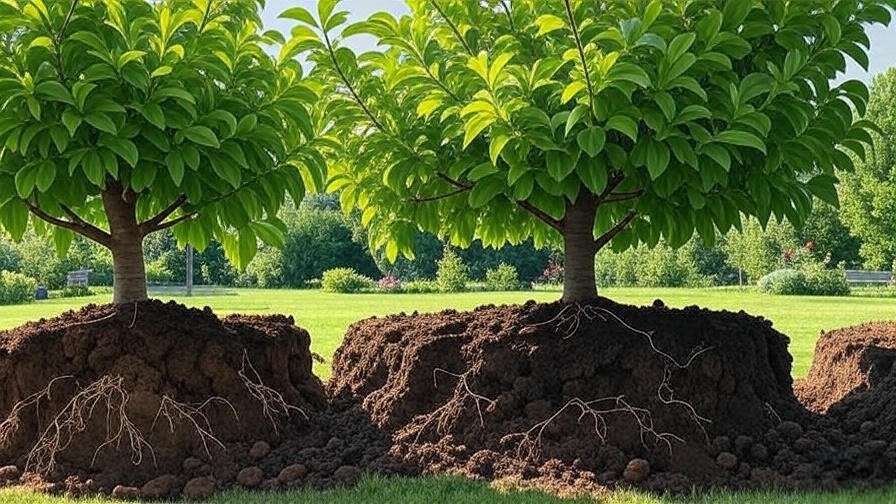
2.2 Climate and Seasonal Considerations
Your local climate dictates watering adjustments:
- Arid Regions: Increase frequency and volume, especially in summer. For example, a cherry orchard in Eastern Washington may need 30% more water than one in humid Oregon.
- Humid Regions: Reduce watering frequency but ensure deep soaking to reach roots.
- Seasonal Shifts: Spring and summer demand more water due to active growth, while fall and winter require less as trees enter dormancy.
Example: A backyard grower in California’s Central Valley might water twice weekly in summer, while an Oregon grower might water once, factoring in rainfall.
2.3 Tree Location and Sun Exposure
Trees in full sun lose water faster due to evaporation, requiring more frequent irrigation than those in partial shade. Trees near reflective surfaces (e.g., concrete patios) or in windy areas may also dry out quicker. Adjust watering by 10–20% for high-exposure locations.
Pro Insight: Apply 2–3 inches of organic mulch (e.g., wood chips or bark) around the tree base to retain moisture and regulate soil temperature. 🌱
3. The Best Cherry Tree Watering Systems: Options and Benefits 💦
Choosing the right watering system depends on your garden size, budget, and goals. Below, we explore five effective options, from manual methods to cutting-edge technology.
3.1 Manual Watering Techniques
- Best for: Small gardens or single trees.
- How it Works: Use a hose or watering can to deliver slow, deep soaking directly to the root zone (within 12–18 inches of the trunk).
- Pros: Low cost, full control over water placement.
- Cons: Time-consuming and impractical for multiple trees.
- Tip: Water in the early morning to minimize evaporation and fungal risks.
3.2 Drip Irrigation Systems
- Best for: Home gardeners and orchards seeking efficiency.
- How it Works: Drip systems use tubing and emitters to deliver water directly to the root zone, minimizing waste. A 2024 study by Washington State University found drip irrigation reduced water use by 50% while improving cherry size and quality.
- Setup Guide:
- Install a main water line connected to a timer.
- Place 1–2 emitters per tree, 12–18 inches from the trunk.
- Set the timer for 30–60 minutes, 1–2 times weekly.
- Pros: Water-efficient, scalable, low maintenance.
- Cons: Initial setup cost ($50–$200 for a small system).
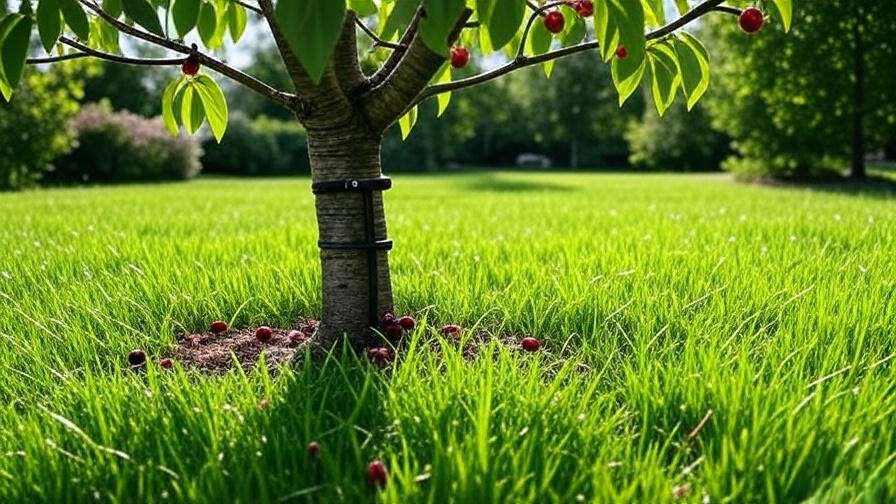
3.3 Soaker Hoses
- Best for: Budget-conscious gardeners.
- How it Works: Soaker hoses release water slowly along their length, ideal for circling around tree bases.
- Pros: Affordable ($20–$50), easy to install.
- Cons: Less precise than drip systems, prone to clogging.
- Maintenance Tip: Flush hoses monthly to prevent sediment buildup.
3.4 Automated Sprinkler Systems
- Best for: Large orchards or commercial growers.
- How it Works: Micro-sprinklers deliver targeted sprays to the root zone. Systems like those from Netafim offer adjustable flow rates.
- Pros: Covers large areas, customizable.
- Cons: Higher cost ($500+ for a small orchard), potential overspray.
- Cost-Benefit: Initial investment is offset by labor savings and improved yields over 3–5 years.
3.5 Smart Watering Technology
- Best for: Tech-savvy gardeners.
- How it Works: Soil moisture sensors and app-controlled timers (e.g., Rain Bird or Rachio) adjust watering based on real-time conditions.
- Case Study: A Michigan cherry grower reported a 25% yield increase after adopting smart irrigation, per a 2024 report by Michigan State University.
- Pros: Precise, eco-friendly, remote control.
- Cons: Higher cost ($100–$300), requires tech setup.
| System | Cost | Efficiency | Best For |
|---|---|---|---|
| Manual | $0–$20 | Low | Small gardens |
| Drip Irrigation | $50–$200 | High | Home gardens, orchards |
| Soaker Hose | $20–$50 | Medium | Budget gardeners |
| Sprinkler | $500+ | Medium-High | Large orchards |
| Smart Technology | $100–$300 | Very High | Tech-savvy growers |
4. How to Implement the Best Cherry Tree Watering System 🌟
Now that you’ve explored the top watering systems, it’s time to put them into action. Implementing The Best Cherry Tree Watering System for Maximum Growth starts with assessing your needs and following a clear, expert-guided process. Below, we outline how to choose, install, and maintain your system for optimal results.
4.1 Assessing Your Needs
To select the right watering system, evaluate the following:
- Number of Trees: A single tree may only need manual watering or a soaker hose, while multiple trees benefit from drip or sprinkler systems.
- Soil Type: Sandy soils need frequent watering; clay soils require less. Test drainage by watering a small area and checking how long it takes to absorb.
- Climate: Arid regions demand more water; humid areas need careful monitoring to avoid overwatering.
- Budget: Manual watering is free, while drip systems cost $50–$200, and smart systems range from $100–$300.
- Time Commitment: Automated systems save time but require setup; manual methods are labor-intensive.
Checklist:
- Count your cherry trees.
- Test soil drainage and pH (ideal: 6.0–7.0).
- Note local rainfall and temperature patterns.
- Set a budget for equipment.
4.2 Step-by-Step Installation Guide
Here’s a universal guide for setting up a drip irrigation system, adaptable to soaker hoses or sprinklers:
- Plan Your Layout: Map out your trees and water source (e.g., outdoor faucet). Ensure tubing reaches all trees.
- Gather Materials: Purchase a drip irrigation kit (tubing, emitters, connectors, timer) or soaker hoses. Brands like Rain Bird or Orbit are reliable.
- Install the Main Line: Connect tubing to your water source with a pressure regulator and filter to prevent clogs.
- Place Emitters: Position 1–2 emitters per tree, 12–18 inches from the trunk, to target the root zone.
- Set a Timer: Program for early morning watering (30–60 minutes, 1–2 times weekly, adjusted for rainfall).
- Test the System: Run water to check for leaks or uneven flow, adjusting emitters as needed.
Visual Tip: Place emitters in a semicircle around the tree to cover the drip line (the area under the outer edge of the canopy).
4.3 Watering Schedules for Maximum Growth
A consistent schedule ensures your cherry trees thrive. Adjust based on tree age, season, and rainfall:
- Young Trees: 5–10 gallons weekly, split into 2–3 sessions (e.g., 2 gallons every 2–3 days).
- Mature Trees: 20–30 gallons every 7–10 days, delivered in one deep soaking.
- Fruit-Bearing Season: 25–35 gallons weekly, especially during flowering and fruit set (April–June).
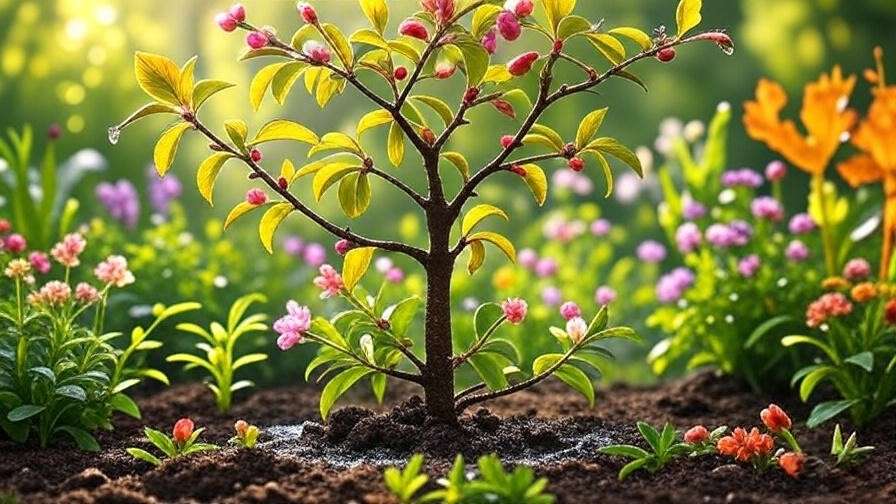
Sample Schedule (Moderate Climate, Loamy Soil):
- Spring: 20 gallons weekly for mature trees, 10 gallons for young trees.
- Summer: 25–30 gallons weekly, checking soil moisture to avoid drought stress.
- Fall: 15–20 gallons every 10 days as growth slows.
- Winter: 5–10 gallons every 2 weeks, only if rainfall is insufficient.
Expert Tip: Use a rain gauge to measure natural precipitation and subtract it from your watering plan. For example, if your tree needs 20 gallons and you get 0.5 inches of rain (about 3 gallons for a 4-foot canopy), reduce irrigation to 17 gallons. ☔
5. Common Watering Mistakes and How to Avoid Them 🚫
Even experienced gardeners can make watering errors that harm cherry trees. Here’s how to avoid the most common pitfalls.
- Mistake 1: Overwatering Leading to Root Rot
- Signs: Yellowing leaves, soggy soil, or a musty smell near roots.
- Solution: Test soil moisture with a meter or dig 6 inches down—if it’s wet, skip watering. Improve drainage with organic matter or raised beds.
- Mistake 2: Inconsistent Watering Causing Fruit Cracking
- Signs: Split or cracked cherries, especially after heavy rain or irregular watering.
- Solution: Maintain a steady schedule, especially during fruit development (May–June). Use mulch to stabilize soil moisture.
- Mistake 3: Ignoring Soil Health
- Signs: Poor growth despite regular watering.
- Solution: Test soil pH and nutrients annually (kits available at garden centers). Aim for pH 6.0–7.0 and supplement with compost or balanced fertilizer (e.g., 10-10-10).
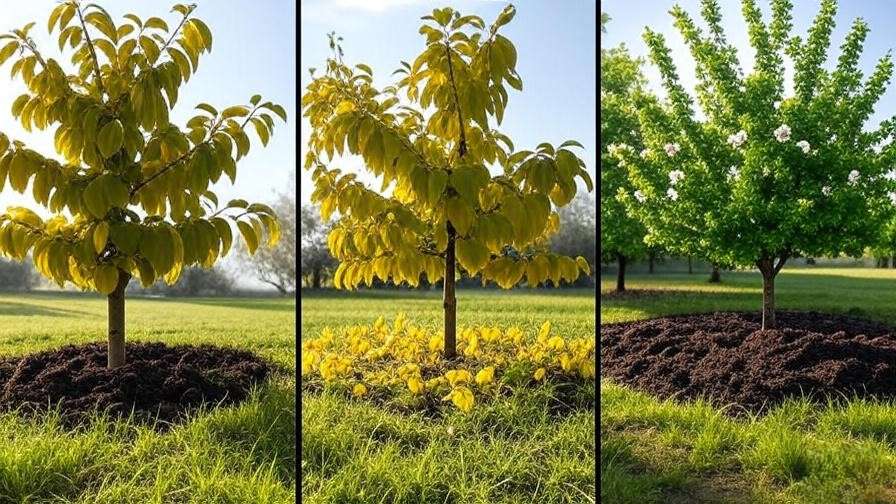
| Issue | Symptoms | Solution |
|---|---|---|
| Overwatering | Yellow leaves, soggy soil | Check moisture, improve drainage |
| Inconsistent Watering | Cracked fruit, wilting | Stick to a schedule, use mulch |
| Poor Soil Health | Stunted growth, low yields | Test soil, add compost or fertilizer |
6. Enhancing Cherry Tree Health Beyond Watering 🌼
While The Best Cherry Tree Watering System for Maximum Growth is critical, complementary practices amplify your success.
6.1 Complementary Practices
- Mulching: Apply 2–3 inches of organic mulch (wood chips, straw, or bark) around the tree base, keeping it 2 inches from the trunk to prevent rot. Mulch reduces evaporation by up to 20% and keeps roots cool, per a 2023 study by Oregon State University.
- Fertilization: Pair watering with a balanced fertilizer (e.g., 10-10-10) in early spring to support growth. Avoid over-fertilizing, which can stress trees.
- Pruning: Prune in late winter to remove dead or crowded branches, improving water efficiency and air circulation.
6.2 Pest and Disease Prevention
Proper watering reduces stress, making trees less susceptible to pests and diseases. For example:
- Powdery Mildew: Thrives in humid, poorly watered conditions. Ensure deep watering and good air circulation.
- Cherry Fruit Fly: Healthy, well-watered trees resist pest damage better. Monitor for larvae and use organic traps if needed.
Pro Insight: A stressed tree is a magnet for pests like aphids or borers. Consistent watering and mulching create a resilient tree. 🐞
7. FAQs About Cherry Tree Watering ❓
- How much water does a cherry tree need weekly?
Young trees need 5–10 gallons, mature trees 20–30 gallons, and fruit-bearing trees 25–35 gallons, adjusted for rainfall. - Can I overwater my cherry tree?
Yes, overwatering causes root rot. Check soil moisture before watering and ensure proper drainage. - What’s the best time of day to water?
Early morning minimizes evaporation and fungal risks. Avoid evening watering to prevent mold. - How do I know if my tree is getting enough water?
Dig 6 inches into the soil; it should feel moist but not soggy. Wilting leaves or small fruit indicate under-watering. - Are there eco-friendly watering systems for cherry trees?
Drip irrigation and smart systems reduce water waste by up to 50%, making them sustainable choices for The Best Cherry Tree Watering System for Maximum Growth.
8. Conclusion: Grow Thriving Cherry Trees with the Right Watering System 🎉
Achieving lush, productive cherry trees starts with The Best Cherry Tree Watering System for Maximum Growth. By assessing your needs, choosing the right system (drip, soaker, or smart technology), and avoiding common mistakes, you can boost yields and tree health. Pair your watering plan with mulching, fertilization, and pruning for even better results. Start today by evaluating your garden and implementing these expert-backed techniques. Share your cherry tree success stories in the comments, and explore more tree care tips on our website! 🌸

